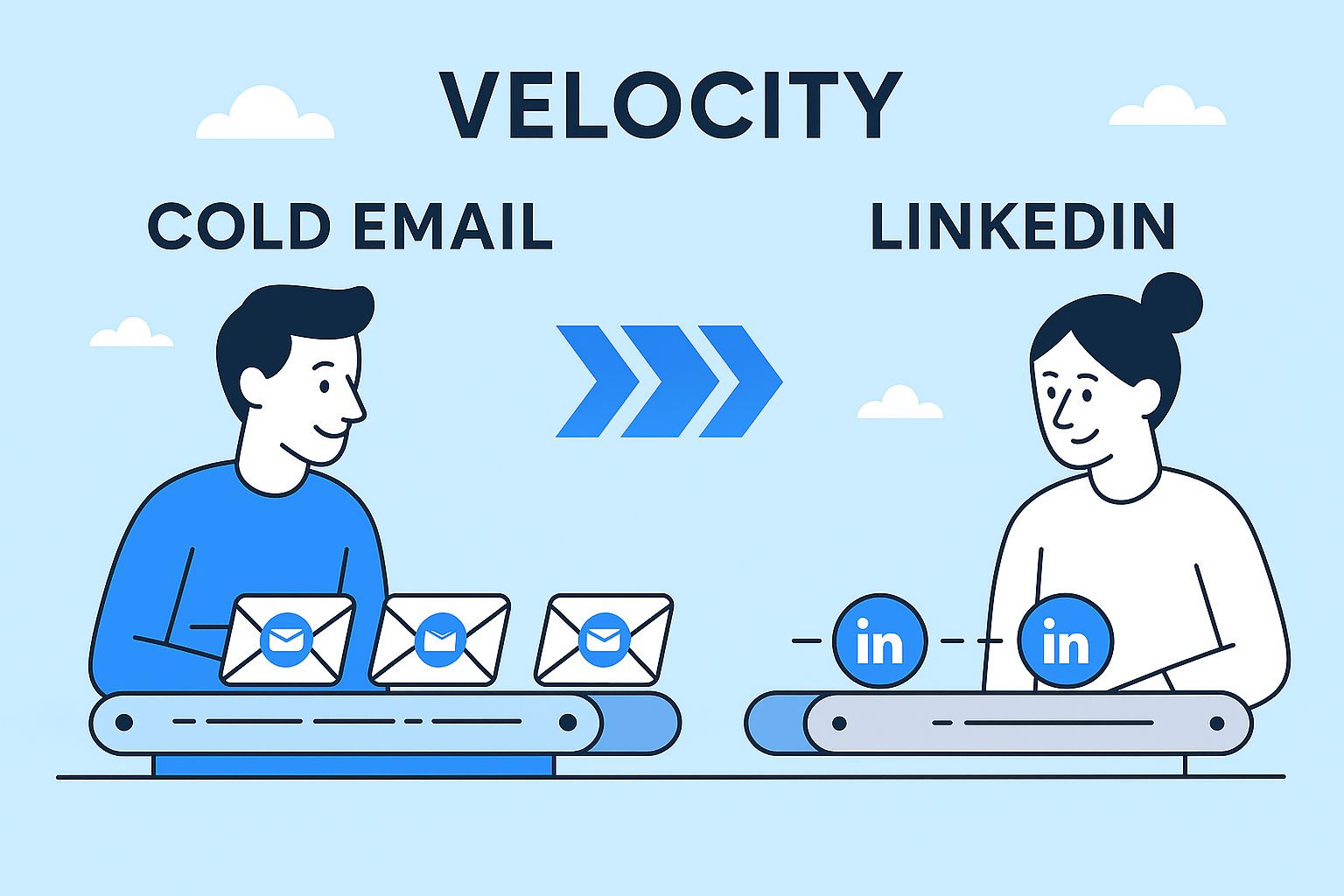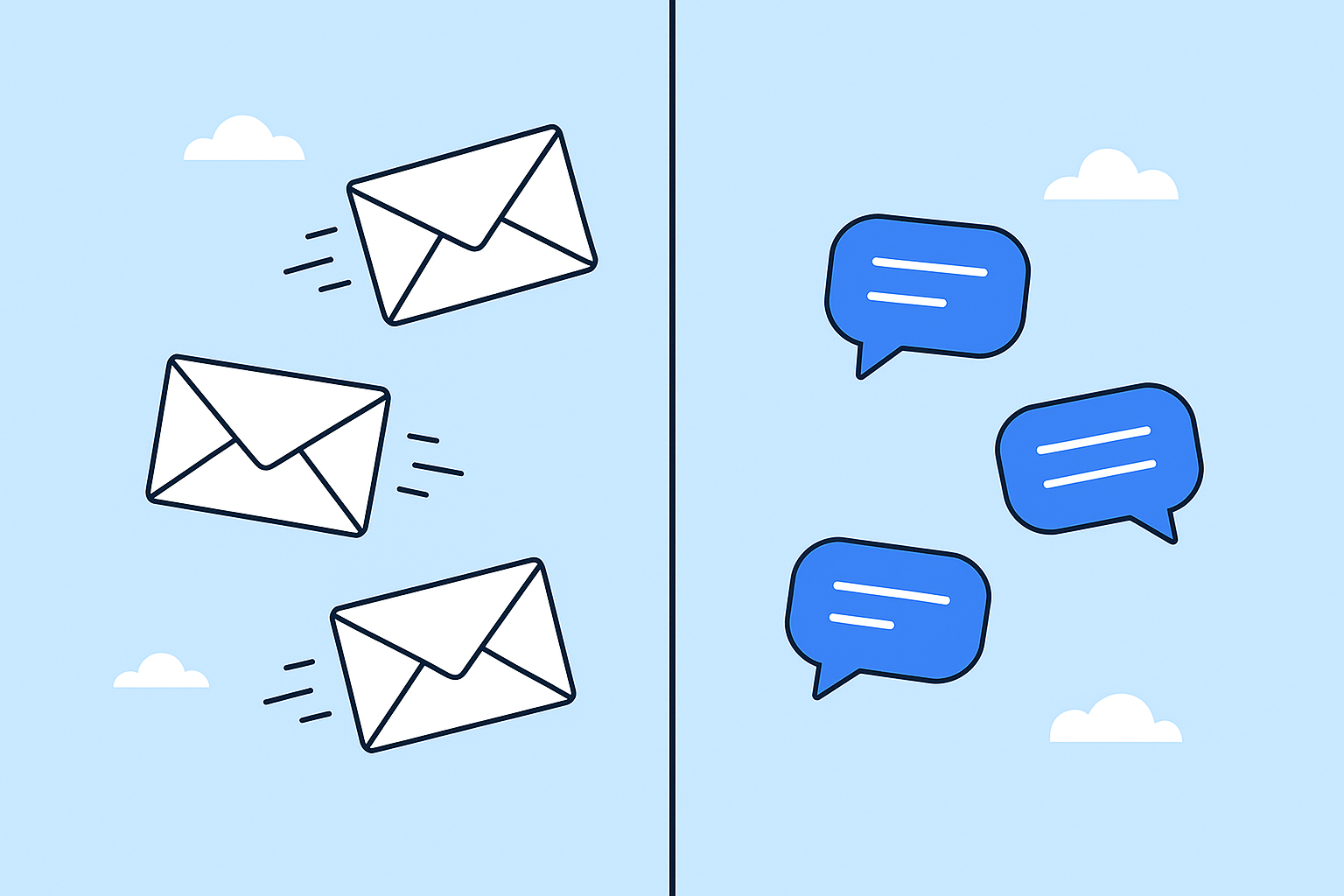When you are trying to start conversations with new prospects, two channels usually come to mind: cold email and LinkedIn. Both can open doors, but they work in very different ways.
Cold email gives you scale. You can reach hundreds of prospects quickly, test messaging, and build a predictable pipeline. The challenge is getting your emails into the inbox and standing out in a crowded space.
LinkedIn gives you trust. Your message lands in a professional setting where people are already in business mode. The trade-off is that it is harder to scale and often more expensive if you rely on tools like InMail.
So which one is right for you? In this guide, we will break down how cold email and LinkedIn compare across open rates, response rates, deliverability, costs, and more. Stick around until the end, and you will have a clear framework to choose the right channel for your goals, or to combine both for maximum results.
Cold Email vs LinkedIn Outreach: 7 Features to Look At
1. Open Rate
LinkedIn messages, especially InMails, often see higher open rates because they arrive in a trusted, professional environment where recipients are already in “business mode.”
Cold emails, however, can still compete when done right. Success depends heavily on factors like list quality, subject lines, and content. Highly personalized emails that avoid looking like bulk outreach can achieve strong open rates — and when deliverability is optimized, they often match or even outperform LinkedIn in visibility.
LinkedIn’s built-in advantage is context. Messages feel relevant, and InMails go a step further by bypassing connection limits and signaling extra credibility. Still, with the right approach, cold email remains a reliable channel for capturing attention at scale.
![]()
2. Response Rate
LinkedIn messages, especially InMails, usually deliver higher response rates than cold emails because they arrive in a professional context where people are more open to networking and business discussions. Cold emails can still convert well, but only when they are personalized and supported with timely follow-ups.
Response rate is one of the clearest signs that your outreach is working. Cold emails often struggle here because many land in spam or get lost in crowded inboxes, but personalization and persistence can improve performance. LinkedIn has the advantage because messages feel more relevant in-platform, and InMails often boost response rates further thanks to their paid, credible nature that helps cut through the noise.
3. Deliverability
LinkedIn messages, including InMails, almost always reach the recipient because they bypass spam filters and stay within the platform.
Cold emails face more deliverability challenges, but that does not make them less effective — it simply means success depends on proper setup. List quality, warmup, and sender reputation determine whether your emails land in the inbox or get filtered out. With the right deliverability practices and tools, cold email can achieve reliable inbox placement and scale far beyond what LinkedIn allows.
InMails carry extra credibility inside LinkedIn, but cold email gives you ownership over your outreach channel. When optimized correctly, it remains one of the most powerful ways to ensure your message is seen.
4. Velocity
Cold email can scale to thousands of sends per day if your sender reputation is strong and you follow best practices. LinkedIn limits daily outreach to protect users from spam, though InMails allow for more frequent messaging with fewer restrictions.
Email velocity is all about balance. With cold email, service providers and spam filters set the boundaries, and sending too many messages too quickly can damage your domain reputation. LinkedIn applies stricter daily caps that vary by account type and activity level, while InMails provide more flexibility to reach a higher volume of prospects in a shorter timeframe, albeit at a cost.
5. Follow-ups
Cold email is stronger for automated, scalable follow-ups, while LinkedIn follow-ups feel more personal and can help build rapport in a professional context.
Follow-ups are often where deals are won. With cold email, automation tools make it easy to send timely reminders, address objections, or share additional resources without heavy manual effort. When deliverability is optimized, these follow-ups consistently land in the inbox and keep prospects engaged at scale.
LinkedIn follow-ups, on the other hand, are more relationship-driven. A thoughtful message after a connection request or initial outreach can reference past conversations and add value tied to someone’s professional interests. This personal touch often improves response rates, but it is much harder to automate and scale.
Cold email follow-ups, therefore, offer both reach and consistency, especially when backed by strong deliverability practices, while LinkedIn works best as a complementary channel for adding a personal touch.
Read also: Cold Email Follow-Up – How to Get Your Prospect to Respond
6. Scale
Cold email scales faster because you can send thousands of messages with automation. LinkedIn is harder to scale but offers more precise targeting of decision-makers and niche audiences.
Cold email is built for volume. With the right tools, you can manage large lists, automate follow-ups, and reach a broad audience quickly. This makes it the go-to option for widespread lead generation and top-of-funnel outreach.
LinkedIn, on the other hand, excels at targeted scale. Automation tools can help you send connection requests and follow-up sequences, but volume is capped to protect users from spam. The trade-off is quality: you are reaching people in a professional context with messages that feel more personal.
7. Automation
Automation is a key part of modern outreach, and both cold email and LinkedIn offer ways to scale without losing too much personal touch.
Cold email has the clear advantage here. Email automation platforms let you personalize at scale, schedule follow-ups, and track performance — all while reaching far more people than you could manually. When deliverability is strong, this automation turns into consistent, high-volume engagement.
LinkedIn also has automation tools for connection requests, messaging, and prospecting, but they come with stricter limits and higher risk if overused. While useful for targeted campaigns, they cannot match the efficiency and control that email automation provides.
Effective outreach depends on balancing automation with personalization, but for teams that want both scale and flexibility, cold email automation remains the more powerful option.
8. Ease of Use
Both cold email and LinkedIn are designed to be user-friendly, but they offer different experiences.
Cold email platforms make campaign management simple with features like personalization, segmentation, automated follow-ups, and performance tracking. Once set up, they let you run outreach at scale with minimal friction.
LinkedIn’s built-in interface is intuitive for one-to-one networking, with messaging, connection requests, and profile interactions all in one place. However, it is less flexible for large campaigns and can feel limiting if you need advanced reporting or automation.
For quick, one-off outreach, LinkedIn is easy to use. For teams that want control, scalability, and deeper analytics, cold email software provides a more powerful and efficient workflow.
9. Cost
Cold email is usually the most cost-effective option. With affordable senders like Amazon SES (about $1 per 10,000 emails) and a standard email account, your main expense is deliverability support, which ensures your emails actually land in the inbox. Even with a tool like InboxAlly, the cost per 1,000 sends is still very low compared to LinkedIn.
LinkedIn outreach is far more expensive. A Sales Navigator plan costs around $120 per month and includes only 50 InMail credits, which works out to about $2–$3 per send. Sponsored Message Ads can cost $260–$500 per 1,000 sends. That means LinkedIn is best for targeted, high-value contacts, while cold email offers broad reach at a fraction of the price.
10. Data Management
Efficient data management is crucial for maintaining the accuracy and effectiveness of outreach campaigns. Cold email campaigns require effective data management practices, including regular email verification and segmentation.
On the other hand, LinkedIn provides built-in contact management tools, allowing you to organize and track conversations within the platform. In terms of data management, both cold emails and LinkedIn messages have their own considerations.
So, it’s important to implement proper data management practices regardless of the outreach method you choose.
Merge Emails and LinkedIn Messages for Better Results
The good news is you don’t have to choose between cold email and LinkedIn; the best results often come from using both together.
Start with a personalized cold email to introduce yourself and share your value proposition. Once you’ve made contact, follow up on LinkedIn to reinforce the message and build credibility in a professional setting. This one-two approach combines email’s scalability with LinkedIn’s trust factor.
If you use LinkedIn’s premium features like InMail, you can extend your reach even further to decision-makers and hard-to-access prospects. Just make sure your outreach stays relevant and respectful so it feels like a natural conversation, not spam.
By combining both channels, you increase visibility, strengthen relationships, and improve your chances of getting meaningful responses.
Final Verdict: Should You Use Cold Email or LinkedIn?
If you need a broad reach at a lower cost, cold email is your best friend. It scales fast and lets you start conversations with hundreds of prospects at once. Just keep in mind that inbox placement is everything. Without strong deliverability, even the best email will not get seen.
If your goal is fewer but higher-quality conversations, LinkedIn shines. Messages arrive in a trusted environment where professionals are already in “business mode,” which often leads to higher reply rates.
But here is the smarter play: do not limit yourself. Many of the most successful teams pair both channels. Start with a well-crafted cold email, then reinforce the relationship on LinkedIn. This one-two punch gives you visibility, credibility, and responses.
And if cold email is in your mix, do not leave inbox placement to chance. InboxAlly helps ensure your messages actually land where they belong, in the primary inbox, so your outreach efforts turn into real conversations.
FAQs on Cold Email and LinkedIn Outreach
About the author:
Darren Blumenfeld is the CEO and Founder of InboxAlly, an email deliverability platform trusted by growth-focused marketers. He’s previously founded HonestMail, worked at NASA, and holds degrees from Tufts and Columbia. His passion for tech, education, and creativity continues to inspire innovation in email outreach.

